Science nugget: 3He-rich solar energetic particle events observed close to the Sun on Solar Orbiter - Solar Orbiter
3He-rich solar energetic particle events observed close to the Sun on Solar Orbiter
(Solar Orbiter nugget #12 by G. M. Mason1, R. Bučik2, and the Solar Orbiter/EPD team)
Introduction
Solar energetic particle (SEP) events are studied intensively since they can fill the inner solar system with ionizing radiation and are the most energetic particle accelerators in the solar system. The Solar Orbiter mission [1] is providing opportunities for better understanding of how these events accelerate and release particles into the interplanetary space, and how they are transported in the solar system. The most abundant SEP events are small “impulsive” events that take place by the thousands in active periods, and show unique properties such as high electron abundances, radio bursts, and ions with abundance mixtures greatly modified from solar material [2, 3].
The Solar Orbiter perihelion pass of March-April 2022
In March 2022, Solar Orbiter had its 4th perihelion flyby, reaching 0.32 of the Earth-Sun distance (au) on March 26. During this pass the Energetic Particle Detector suite [4] observed two series of 3He-rich events.
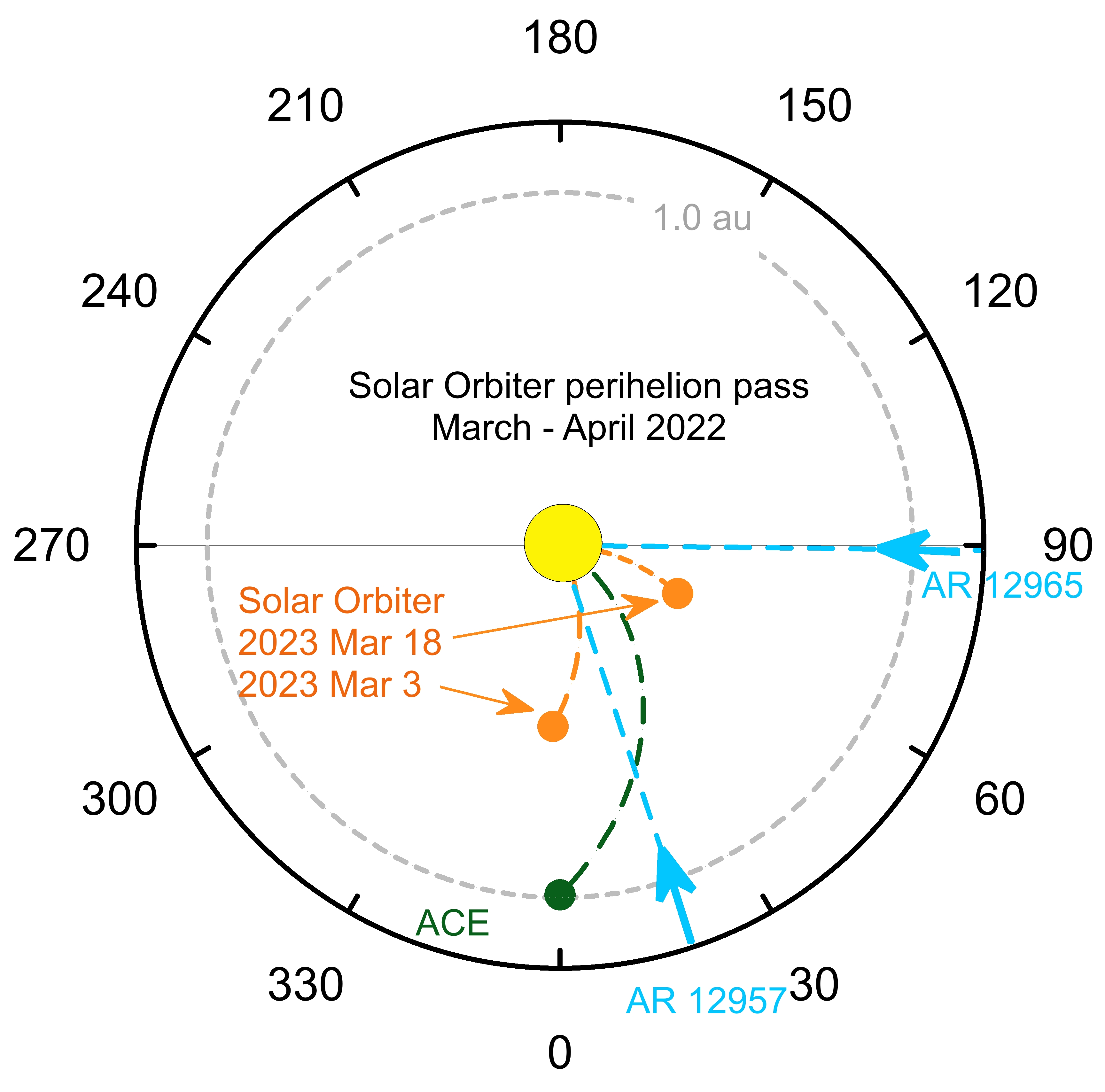
Figure 1. Solar Orbiter locations when the events were observed in March 2022. The radial distance was 0.55 au for the series of events starting March 3, and 0.37 au for the series starting March 18. Earth is located at 0 degrees in the figure.
On March 3 the first series began, originating in a magnetic active region (AR 12957) located on the western hemisphere of the Sun as viewed from Earth. A strong injection of particles on March 3 can be seen at the left in Figure 2.
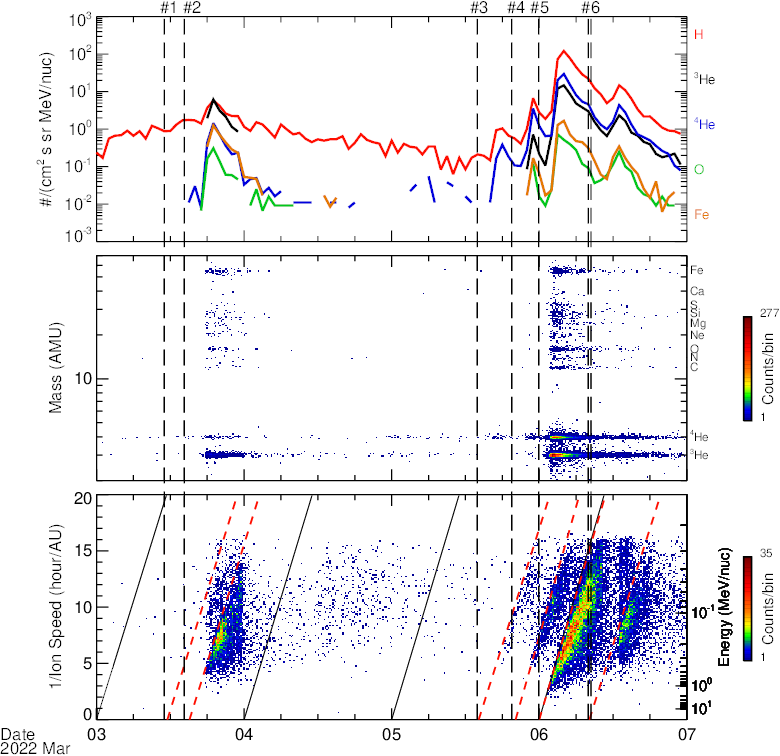
Figure 2: energetic ion intensities March 3-7; top panel are intensity levels of H, He, and other ions; middle panel show ion masses up to Fe, and lower panel shows ion arrival times
Close inspection reveals two separate injections shown with dashed red lines, and numbered 1 and 2 in coincidence with radio bursts shown in Figure 3.
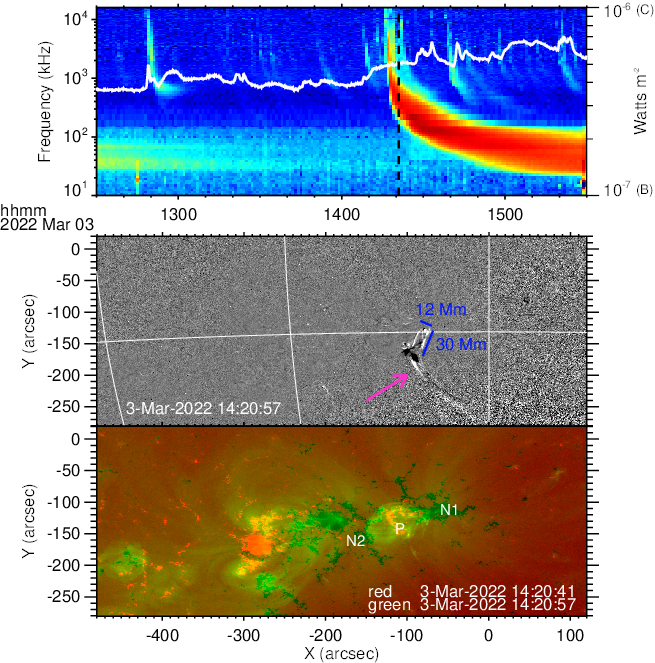
Figure 3, top panel: type III radio bursts on March 3; middle panel magnetic active region with jets at the time of the energetic particle event; bottom panel: details of magnetic field in the active region.
The second radio burst starting around 14:16 moves from high to lower frequencies due to plasma waves excited by energetic electrons escaping the Sun and moving into interplanetary space where the wave frequencies are lower since the plasma density decreases at greater distances from the Sun. This middle panel of Fig. 3 shows two bright loops and jets, as is shown in the movie below, which are the source of event #2.
The magnetic configuration (lower panel of Figure 3) and jet activity are consistent with the model of reconnecting magnetic fields due to emerging flux emanating from below the surface [5, 6, 7]. Other events in the series shown in Figure 2 all showed enrichments in 3He but with interesting differences that may give clues to the accelerating process. Event #5 had the highest intensities and its associated jet was almost twice the size of the jet in #2. The other events (#1, #3, #4, #6) all had lower intensities and smaller brightening and minor jets. This is consistent with the suggestion that larger acceleration regions produce larger events [8]. Other features of these regions (see the A&A special issue) showed a network of crisscrossing loops that may correspond to the simulated turbulent magnetic coronal structures that may enhance acceleration is impulsive flares [9,10].
The second series of events was observed on March 18-19 when Solar Orbiter had moved much closer to the Sun, 0.37 au. A series of very closely spaced events took place, with about 15 injections in less than 24 hours. Figure 4 shows the speed arrival times, where the different ion injections are numbered, and dotted lines guide the eye to show correspondence with the arrival of electrons at Solar Orbiter, and radio type III bursts observed by the Solar Orbiter Radio and Plasma Waves (RPW) experiment [11].
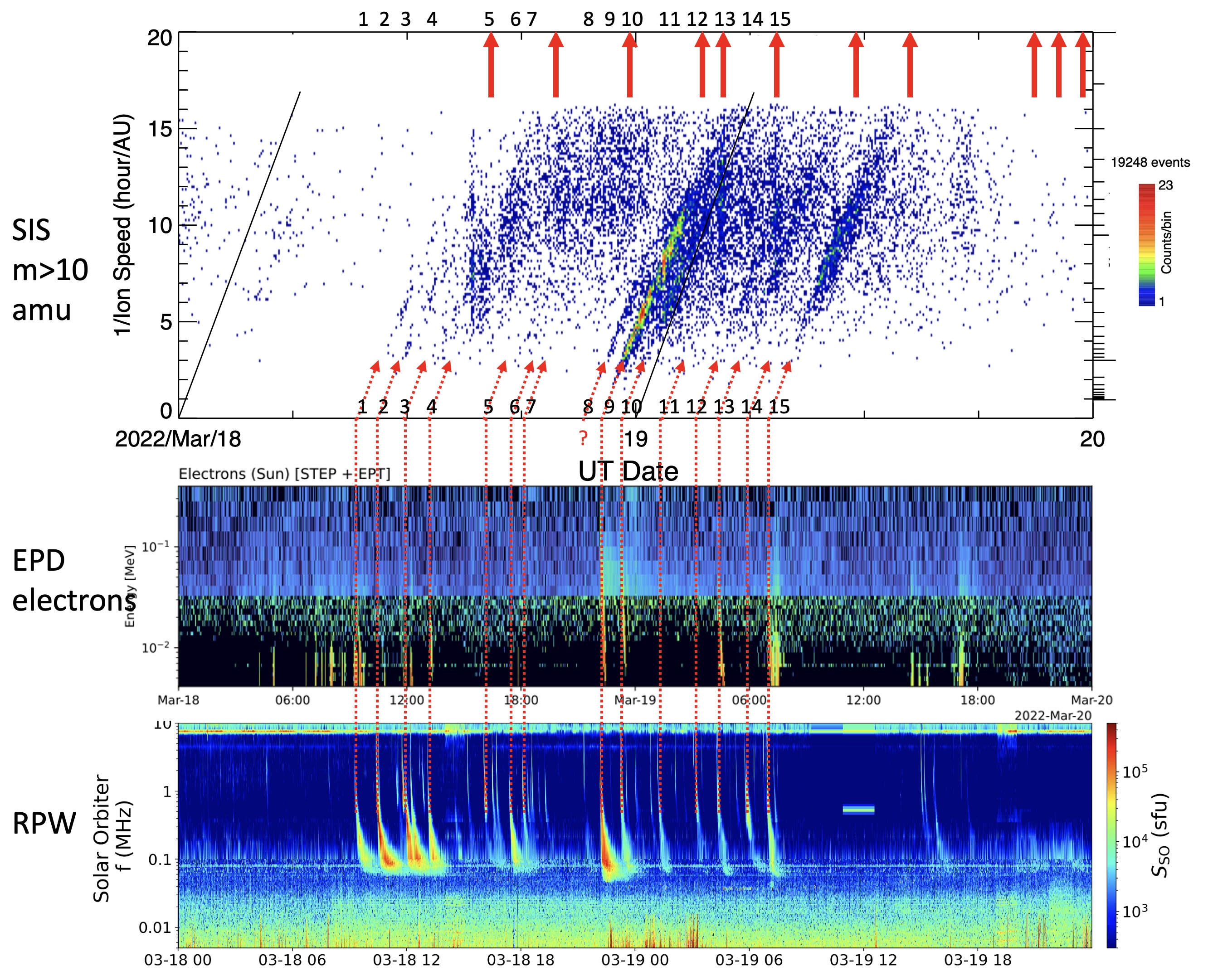
Figure 4: top panel: 10-70 amu 1/speed vs arrival time for the March 18-19 series. Middle panel: electron spectrograms at Solar Orbiter. Bottom panel: type III radio bursts. Note the close correspondence between the 15 events and radio bursts.
Although there was X-ray activity during this time, the event timing (red arrows at the top of Fig. 4) did not line up well with the particle events. Rather, a small loop to the west of the active region shown in Figure 5 was found to the flaring in close coincidence with several of the events.
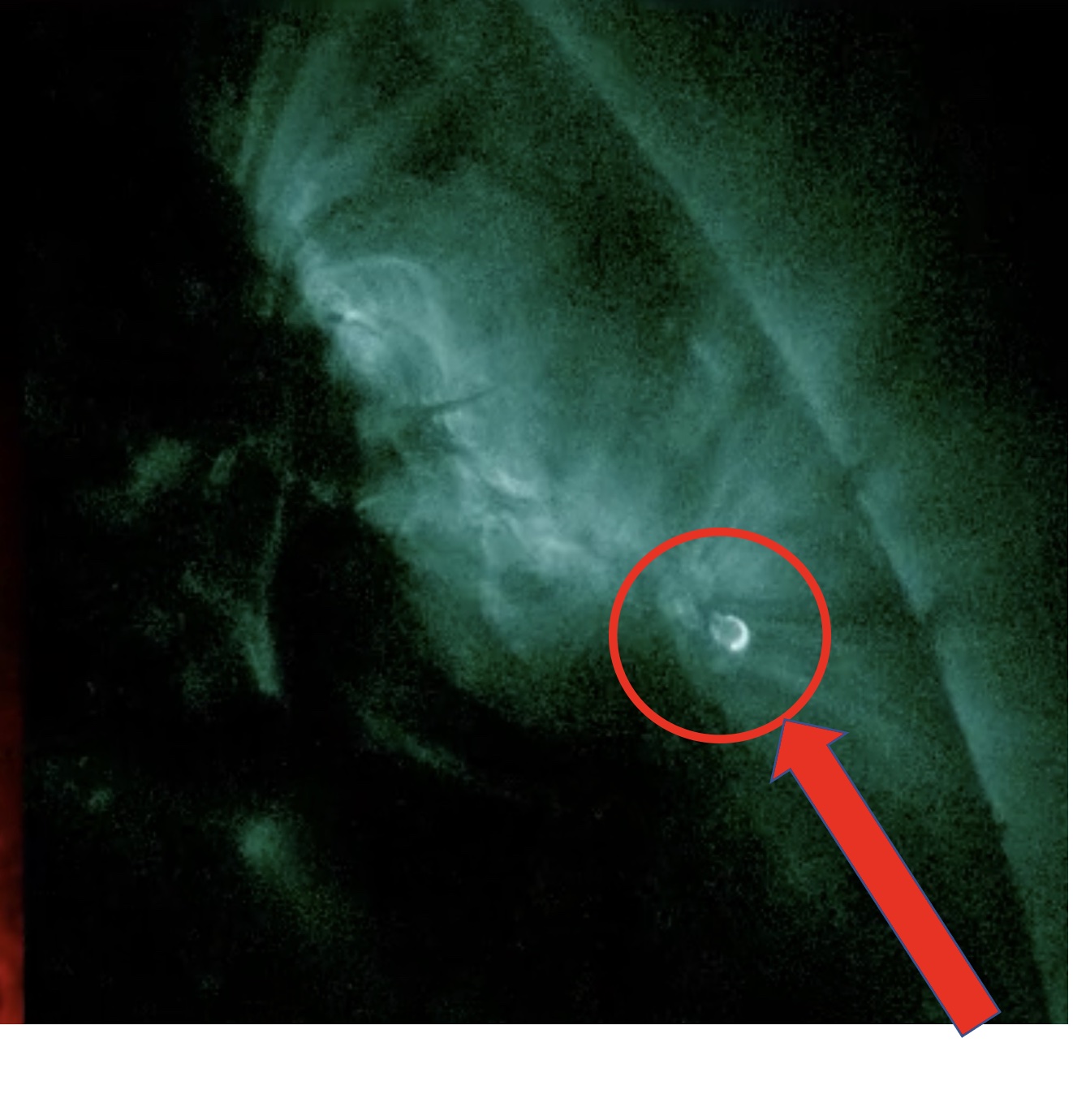
Figure 5: SDO 94 Å (~7-9 MK temperature) image of a small loop to the right of the active region that flared in coincidence with several of the events, as shown in the accompanying movie.
The movie below shows the flaring loop and type III bursts in coincidence:
At this close distance the electrons arrive at Solar Orbiter in just a few minutes so the coincidence between the type III bursts, electrons, and loop flaring have much smaller uncertainties than events viewed further from the Sun. The loop appears to be the source of the energetic ions since the timing coincidence is close and there does not appear to be other activity at the time. There is no obvious coronal hole as was the case for the March 3-7 series, yet the particle escape establishes that there were some open field lines nearby.
Conclusions
Superficially, the events in the March 3-7 series, with jets, coronal holes and active region involvement present a seemingly incompatible picture with the March 18-19 series, with a small flaring loop, no obvious jets or coronal holes, and away from a nearby active region. We take these differences as evidence that the processes that produce type III and 3He-rich events can arise in multiple situations in the corona and are widespread. This is consistent with the presence of 3He in interplanetary space 90-100% of the time during active periods [12]. Thus the events observed during the Solar Orbiter perihelion pass may provide insights into the essential features of the mechanism (emerging flux, reconnection) as opposed to other phenomena that are not actually required (x-ray flares, active region eruptions).
For more details see the associated papers in A&A special issue [13,14].
Acknowledgements
The EPD team acknowledges support for post-launch work at JHU/APL by by NASA contract NNN06AA01C and at CAU by German Space Agency (DLR) grant # 50OT2002. The UAH team acknowledges the financial support by the Spanish Ministerio de Ciencia, Innovacion y Universidades MCIU/AEI Project PID2019- 104863RBI00/AEI/10.13039/501100011033. The EPD Suprathermal Ion Spectrograph (SIS) is a European facility instrument funded by ESA under contract number SOL.ASTR.CON.00004. We thank ESA and NASA for their support of the Solar Orbiter and other missions whose data were used in this report.
Affiliations
1 Applied Physics Laboratory, Johns Hopkins University, Laurel, MD 20723 USA
2 Southwest Research Institute, San Antonio, TX 78238, USA
References
[12] Wiedenbeck, M. E. et al. How Common is Energetic 3He in the Inner Heliosphere? SOLAR WIND TEN: Proceedings of the Tenth International Solar Wind Conference. AIP Conference Proceedings 679, 652 (2003).
- Removed a total of (58) style text-align:left;
- Removed a total of (5) style margin:0;
Nuggets archive
2025
09/04/2025: Bursty acceleration and 3D trajectories of electrons in a solar flare
02/04/2025: Picoflare jets in the coronal holes and their link to the solar wind
19/03/2025: Radial dependence of solar energetic particle peak fluxes and fluences
12/03/2025: Analysis of solar eruptions deflecting in the low corona
05/03/2025: Propagation of particles inside a magnetic cloud: Solar Orbiter insights
19/02/2025: Rotation motions and signatures of the Alfvén waves in a fan-spine topology
12/02/2025: 'Sun'day everyday: 2 years of Solar Orbiter science nuggets that shed light on some of our star's mysteries
22/01/2025: Velocity field in the solar granulation from two-vantage points
15/01/2025: First joint X-ray solar microflare observations with NuSTAR and Solar Orbiter/STIX
2024
18/12/2024: Shocks in tandem : Solar Orbiter observes a fully formed forward-reverse shock pair in the inner heliosphere
11/12/2024: High-energy insights from an escaping coronal mass ejection
04/12/2024: Investigation of Venus plasma tail using the Solar Orbiter, Parker Solar Probe and Bepi Colombo flybys
27/11/2024: Testing the Flux Expansion Factor – Solar Wind Speed Relation with Solar Orbiter data
20/11/2024:The role of small scale EUV brightenings in the quiet Sun coronal heating
13/11/2024: Improved Insights from the Suprathermal Ion Spectrograph on Solar Orbiter
30/10/2024: Temporally resolved Type III solar radio bursts in the frequency range 3-13 MHz
23/10/2024: Resolving proton and alpha beams for improved understanding of plasma kinetics: SWA-PAS observations
25/09/2024: All microflares that accelerate electrons to high-energies are rooted in sunspots
25/09/2024: Connecting Solar Orbiter and L1 measurements of mesoscale solar wind structures to their coronal source using the Adapt-WSA model
18/09/2024: Modelling the global structure of a coronal mass ejection observed by Solar Orbiter and Parker Solar Probe
28/08/2024: Coordinated observations with the Swedish 1m Solar Telescope and Solar Orbiter
21/08/2024: Multi-source connectivity drives heliospheric solar wind variability
14/08/2024: Composition Mosaics from March 2022
19/06/2024: Coordinated Coronal and Heliospheric Observations During the 2024 Total Solar Eclipse
22/05/2024: Real time space weather prediction with Solar Orbiter
15/05/2024: Hard X ray and microwave pulsations: a signature of the flare energy release process
01/02/2024: Relativistic electrons accelerated by an interplanetary shock wave
11/01/2024: Modelling Two Consecutive Energetic Storm Particle Events observed by Solar Orbiter
2023
14/12/2023: Understanding STIX hard X-ray source motions using field extrapolations
16/11/2023: EUI data reveal a "steady" mode of coronal heating
09/11/2023: A new solution to the ambiguity problem
02/11/2023: Solar Orbiter and Parker Solar Probe jointly take a step forward in understanding coronal heating
25/10/2023: Observations of mini coronal dimmings caused by small-scale eruptions in the quiet Sun
18/10/2023: Fleeting small-scale surface magnetic fields build the quiet-Sun corona
27/09/2023: Solar Orbiter reveals non-field-aligned solar wind proton beams and its role in wave growth activities
20/09/2023: Polarisation of decayless kink oscillations of solar coronal loops
23/08/2023: A sharp EUI and SPICE look into the EUV variability and fine-scale structure associated with coronal rain
02/08/2023: Solar Flare Hard Xrays from the anchor points of an eruptive filament
28/06/2023: 3He-rich solar energetic particle events observed close to the Sun on Solar Orbiter
14/06/2023: Observational Evidence of S-web Source of Slow Solar Wind
31/05/2023: An interesting interplanetary shock
24/05/2023: High-resolution imaging of coronal mass ejections from SoloHI
17/05/2023: Direct assessment of far-side helioseismology using SO/PHI magnetograms
10/05/2023: Measuring the nascent solar wind outflow velocities via the doppler dimming technique
26/04/2023: Imaging and spectroscopic observations of EUV brightenings using SPICE and EUI on board Solar Orbiter
19/04/2023: Hot X-ray onset observations in solar flares with Solar Orbiter/STIX
12/04/2023: Multi-scale structure and composition of ICME prominence material from the Solar Wind Analyser suite
22/03/2023: Langmuir waves associated with magnetic holes in the solar wind
15/03/2023: Radial dependence of the peak intensity of solar energetic electron events in the inner heliosphere
08/03/2023: New insights about EUV brightenings in the quiet sun corona from the Extreme Ultraviolet Imager








































 Sign in
Sign in
 Science & Technology
Science & Technology